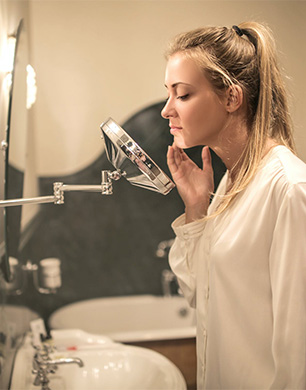
Photo Credit:
Andrea Piacquadio via www.pexels.com
There are at-home, and surgical or non-surgical procedures that are proven to heal acne scars. Visit Dr Darren McKeown acne scar treatment Glasgow for surgical and non-surgical treatments.
When you deal with active acne breakouts as a teenager, you never imagine that it will follow you into your adult years. Even though hormones for both women and men stabilise in their 20s, there is one thing that may be permanent forever, and that’s acne scarring.
While there’s not much you could have done about active breakouts in your teenage years, you can address acne scarring now, and even in the comfort of your own home.
There are two categories of acne scars, including:
- Atrophic scars (depressed scars) – These scars sit below the skin’s surface if you have a lack of collagen in the skin and acne occurs, such as boxcar scars, icepick scars, and rolling scars.
- Hypertrophic scars (raised scars) – Scars common with chest and back acne on the skin’s surface caused by having too much collagen in the skin, such as dark spots.
At-Home Treatment Options
Before starting at-home treatments for acne scarring, it is necessary to consult a dermatologist to be informed about the best treatment option.
Lactic Acid
Lactic acid works wonders for improving the texture of the skin and can be done every 2 to 12 weeks. While improving texture, it also improves pigmentation and lightens your acne scars over time.
Use lactic acid as an ingredient found in serums, peels, and ointments that can all be bought in-store. For a do-it-yourself at-home fix, you can use diluted apple cider vinegar, which has lactic acid, as a spot treatment or toner that can be dabbed with a cotton pad onto the skin.
This solution can be used on any acne scars.
Alpha Hydroxy Acids(AHAs)
AHAs are found in products used to treat acne and remove dead skin cells, as well as clean out the skin’s pores. This at-home treatment option is also used to make acne scars fade and look less noticeable.
This solution can be used on any acne scar.
Retinoids
Topical retinoids are used as a promising acne treatment that smoothes out scarring. Not only does it improve the texture of your skin and reduce discoloration, but it regenerates cells to start the process of healing too. However, when topical retinoids are used on the skin, one must always use sunscreen as this treatment option makes the skin sensitive to the sun. It can be found in creams and serums and can be prescribed as an over-the-counter medication by a healthcare professional.
Retinoids can be found in products that contain retinol and are best for atrophic scars.
Salicylic Acid
Salicylic acid is a common acne healing ingredient. It is commonly found in cleansers and spot treatments and can be used on any type of acne. Salicylic acid cleans pores thoroughly while reducing inflammation, including redness and swelling. It is one of the best at-home treatment options for acne scarring. Salicylic acid is also commonly used in chemical peels and takes a few weeks to generate noticeable results.
Clinical Procedures
Chemical Peels
Chemical peels are not the same as the facial masks you use at home. Instead, it is a procedure that must be performed by a skin care professional. It contains a strong acid that works by removing the skin’s top layer to remove scarring. Since there are many types of chemical peels, it is necessary to first get your skin assessed before agreeing to one.
Dermabrasion
As one of the most common and successful acne scar removal treatments, dermabrasion can be done at your skin care professional’s practice. It is used as a common treatment option to deeply exfoliate the skin’s top layer using a wire brush.
This clinical treatment option is ideal for treating scars on or close to the skin’s surface, such as rolling or boxcar scars.
Fillers
Fillers are used to fill acne scars. This evens out the skin for a smoother appearance and skin texture. It can be made by collagen, commercial fillers, or your body fat.
Fillers get injected under the surface of the skin to smooth atrophic scars and are ideal for someone who has boxcar or rolling scars.
Laser Resurfacing
Like dermabrasion and chemical peels, laser resurfacing removes the skin’s top layer. It generally works much faster than other resurfacing treatments. Once you get laser resurfacing, the treated area is covered with a bandage. It is also effective for skin breakouts and is not recommended for darker skin tones.
Microneedling
Microneedling is a new treatment that involves a professional using a small, needle-studded roller or pen directly on a scar’s surface. When the needles make contact with the skin, the skin heals and produces collagen.
This treatment option is used on atrophic acne scars.

